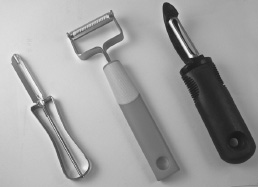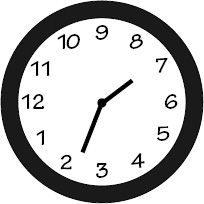Read The Design of Everyday Things Online
Authors: Don Norman
The Design of Everyday Things (43 page)
Some problems are not solved by adjustments or averages: Average a left-hander with a right-hander and what do you get? Sometimes it is simply impossible to build one product that accommodates everyone, so the answer is to build different versions of the product. After all, we would not be happy with a store that sells only one size and type of clothing: we expect clothing that fits our bodies, and people come in a very wide range of sizes. We don't expect the large variety of goods found in a clothing store to apply to all people or activities; we expect a wide variety of cooking appliances, automobiles, and tools so we can select the ones that precisely match our requirements. One device simply cannot work for everyone. Even such simple tools as pencils need to be designed differently for different activities and types of people.
Consider the special problems of the aged and infirm, the handicapped, the blind or near blind, the deaf or hard of hearing, the
very short or very tall, or people who speak other languages. Design for interests and skill levels. Don't be trapped by overly general, inaccurate stereotypes. I return to these groups in the next section.
THE STIGMA PROBLEM
         Â
“I don't want to go into a care facility. I'd have to be around all those old people.”
(Comment by a 95-year-old man.)
Many devices designed to aid people with particular difficulties fail. They may be well designed, they may solve the problem, but they are rejected by their intended users. Why? Most people do not wish to advertise their infirmities. Actually, many people do not wish to admit having infirmities, even to themselves.
When Sam Farber wanted to develop a set of household tools that his arthritic wife could use, he worked hard to find a solution that was good for everyone. The result was a series of tools that revolutionized this field. For example, vegetable peelers used to be an inexpensive, simple metal tool, often of the form shown on the left in
Figure 6.3
. These were awkward to use, painful to hold, and not even that effective at peeling, but everyone assumed that this was how they had to be.

FIGURE 6.3.
  Â
Three Vegetable Peelers.
The traditional metal vegetable peeler is shown on the left: inexpensive, but uncomfortable. The OXO peeler that revolutionized the industry is shown on the right. The result of this revolution is shown in the middle, a peeler from the Swiss company Kuhn Rikon: colorful and comfortable.
After considerable research, Farber settled upon the peeler shown on the right in
Figure 6.3
and built a company, OXO, to manufacture and distribute it. Even though the peeler was designed for someone with arthritis, it was advertised as a better peeler for everyone. It was. Even though the design
was more expensive than the regular peeler, it was so successful that today, many companies make variations on this theme. You may have trouble seeing the OXO peeler as revolutionary because today, many have followed in these footsteps. Design has become a major theme for even simple tools such as peelers, as demonstrated by the center peeler of
Figure 6.3.
Consider the two things special about the OXO peeler: cost and design for someone with an infirmity. Cost? The original peeler was very inexpensive, so a peeler that is many times the cost of the inexpensive one is still inexpensive. What about the special design for people with arthritis? The virtues for them were never mentioned, so how did they find it? OXO did the right thing and let the world know that this was a better product. And the world took note and made it successful. As for people who needed the better handle? It didn't take long for the word to spread. Today, many companies have followed the OXO route, producing peelers that work extremely well, are comfortable, and are colorful. See
Figure 6.3.
Would you use a walker, wheelchair, crutches, or a cane? Many people avoid these, even though they need them, because of the negative image they cast: the stigma. Why? Years ago, a cane was fashionable: people who didn't need them would use them anyway, twirling them, pointing with them, hiding brandy or whisky, knives or guns inside their handles. Just look at any movie depicting nineteenth-century London. Why can't devices for those who need them be as sophisticated and fashionable today?
Of all the devices intended to aid the elderly, perhaps the most shunned is the walker. Most of these devices are ugly. They cry out, “Disability here.” Why not transform them into products to be proud of? Fashion statements, perhaps. This thinking has already begun with some medical appliances. Some companies are making hearing aids and glasses for children and adolescents with special colors and styles that appeal to these age groups. Fashion accessories. Why not?
Those of you who are young, do not smirk. Physical disabilities may begin early, starting in the midtwenties. By their midforties, most people's eyes can no longer adjust sufficiently to focus over
the entire range of distances, so something is necessary to compensate, whether reading glasses, bifocals, special contact lenses, or even surgical correction.
Many people in their eighties and nineties are still in good mental and physical shape, and the accumulated wisdom of their years leads to superior performance in many tasks. But physical strength and agility do decrease, reaction time slows, and vision and hearing show impairments, along with decreased ability to divide attention or switch rapidly among competing tasks.
For anyone who is considering growing old, I remind you that although physical abilities diminish with
age, many mental capacities continue to improve, especially those dependent upon an expert accumulation of experience, deep reflection, and enhanced knowledge. Younger people are more agile, more willing to experiment and take risks. Older people have more knowledge and wisdom. The world benefits from having a mix and so do design teams.
Designing for people with special needs is often called
inclusive
or
universal design
. Those names are fitting, for it is often the case that everyone benefits. Make the lettering larger, with high-contrast type, and everyone can read it better. In dim light, even the people with the world's best eyesight will benefit from such lettering. Make things adjustable, and you will find that more people can use it, and even people who liked it before may now like it better. Just as I invoke the so-called error message of
Figure 4.6
as my normal way of exiting a program because it is easier than the so-called correct way, special features made for people with special needs often turn out to be useful for a wide variety of people.
The best solution to the problem of designing for everyone is flexibility: flexibility in the size of the images on computer screens, in the sizes, heights, and angles of tables and chairs. Allow people to adjust their own seats, tables, and working devices. Allow them to adjust lighting, font size, and contrast. Flexibility on our highways might mean ensuring that there are alternative routes with different speed limits. Fixed solutions will invariably fail with some
people; flexible solutions at least offer a chance for those with different needs.
Complexity Is Good; It Is Confusion That Is Bad
The everyday kitchen is complex. We have multiple instruments just for serving and eating food. The typical kitchen contains all sorts of cutting utensils, heating units, and cooking apparatus. The easiest way to understand the complexity is to try to cook in an unfamiliar kitchen. Even excellent cooks have trouble working in a new environment.
Someone else's kitchen looks complicated and confusing, but your own kitchen does not. The same can probably be said for every room in the home. Notice that this feeling of confusion is really one of knowledge. My kitchen looks confusing to you, but not to me. In turn, your kitchen looks confusing to me, but not to you. So the confusion is not in the kitchen: it is in the mind. “Why can't things be made simple?” goes the cry. Well, one reason is that life is complex, as are the tasks we encounter. Our tools must match the tasks.
I feel so strongly about this that I wrote an entire book on the topic,
Living with Complexity
, in which I argued that complexity is essential: it is confusion that is undesirable. I distinguished between “complexity,” which we need to match the activities we take part in, and “complicated,” which I defined to mean “confusing.” How do we avoid confusion? Ah, here is where the designer's skills come into play.
The most important principle for taming complexity is to provide a good conceptual model, which has already been well covered in this book. Remember the kitchen's apparent complexity? The people who use it understand why each item is stored where it is: there is usually structure to the apparent randomness. Even exceptions fit: even if the reason is something like, “It was too big to fit in the proper drawer and I didn't know where else to put it,” that is reason enough to give structure and understanding to the
person who stored the item there. Complex things are no longer complicated once they are understood.
Standardization and Technology
If we examine the history of advances in all technological fields, we see that some improvements come naturally through the technology itself, others come through standardization. The early history of the automobile is a good example. The first cars were very difficult to operate. They required strength and skill beyond the abilities of many. Some problems were solved through automation: the choke, the spark advance, and the starter engine. Other aspects of cars and driving were standardized through the long process of international standards committees:
      Â
â¢
 Â
On which side of the road to drive (constant within a country, but variable across countries)
      Â
â¢
 Â
On which side of the car the driver sits (depends upon which side of the road the car is driven)
      Â
â¢
 Â
The location of essential components: steering wheel, brake, clutch, and accelerator (the same, whether on the left- or right-hand side of the car)
Standardization is one type of cultural constraint. With standardization, once you have learned to drive one car, you feel justifiably confident that you can drive any car, anyplace in the world. Standardization provides a major breakthrough in usability.
ESTABLISHING STANDARDS
I have enough friends on national and international standards committees to realize that the process of determining an internationally accepted standard is laborious. Even when all parties agree on the merits of standardization, the task of selecting standards becomes a lengthy, politicized issue. A small company can standardize its products without too much difficulty, but it is much more difficult for an industrial, national, or international body to
agree to standards. There even exists a standardized procedure for establishing national and international standards. A set of national and international organizations works on standards; when a new standard is proposed, it must work its way through the organizational hierarchy. Each step is complex, for if there are three ways of doing something, then there are sure to be strong proponents of each of the three ways, plus people who will argue that it is too early to standardize.

FIGURE 6.4. The Nonstandard Clock.
What time is it? This clock is just as logical as the standard one, except the hands move in the opposite direction and “12” is not in its usual place. Same logic, though. So why is it so difficult to read? What time is being displayed? 7:11, of course.
